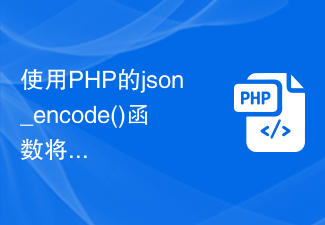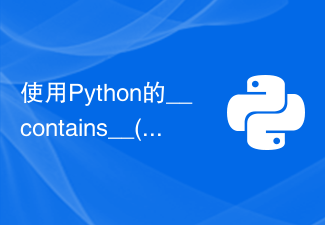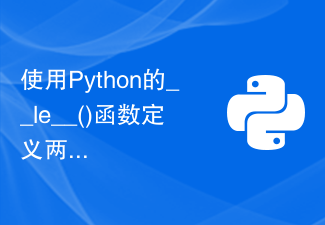Many friends will encounter difficulties in object creation when learning the front-end. Let me teach you some methods. I hope you will learn patiently.
1. Method of creating an object
1. Factory pattern
Create an object in a function and give this Add properties to the object and then return the object in this function. Call this function outside a function to create an instance of the object.
function createPerson(name,age,job){
var o=new Object();//在函数内部创建一个对象
o.name=name;
o.age=age;
o.job=job;
o.sayName=function(){
alert(this.name);
};
return o;//在函数内部返回这个对象
}
var person1=createPerson("xiaowang","22","workers");//在函数外部创建对象的实例,不用new
var person1=createPerson("xiaoliu","22","workers");Problem: The object identification problem is not solved (the type of an object cannot be known)
2. Constructor pattern (can be used to create objects of a specific type)
function Person(name,age,job){//注意构造函数开头的字母应该大写
//构造函数中使用this
this.name=name;
this.age=age;
this.job=job;
this.sayName=function(){
alert(this.name);
}
}
var person1=new Person("xiao",22,"tech");//使用new创建实例
var person2=new Person("li",32,"sin");Differences from the factory pattern:
(1) No explicit creation of objects
(2) Directly assign properties and methods to the object pointed to by this
(3) There is no return statement
Both instances have a constructor attribute pointing to Person.
The constructor can identify what type of object its instance is, and it is more reliable to use the instanceof operator.
Q: What is the difference between a constructor and an ordinary function?
Answer: The constructor is called using the new operator, and the ordinary function is called without new.
Problem with constructor: Each method must be recreated on each instance.
3. Prototype pattern
The properties and methods shared by object instances are not placed in the constructor, but all in the prototype object.
function Person(){ };//构造函数什么也不设置
Person.prototype.name="xiao";//全部都放在原型对象上
Person.prototype.age=22;
Person.prototype.job="stu"'
Person.prototype.sayName=function(){
alert(this.name);
}
var person1=new Person();
var person2=new Person();
console.log(person1.sayName==person2.sayName);//trueProblem with the prototype pattern: For attributes containing application type values, due to the sharing of the prototype pattern, if the reference type value of one instance is changed, the attribute values of other instances will also be changed. .
function Person={}
Person.prototype={
constructor:Person,
name:"Nick",
age:29,
friends:['a','b'];//引用类型的值
sayName:function(){
alert(this.name);
}
}
var person1=new Person();
var person2=new Person();
//想要改变person1实例的friends属性
person1.friends.push("c);
alert(person1.friends);//["a","b","c"]
alert(person2.friends);//["a","b","c"];
alert(person1.friends==person2.friends);//true;4. Combination pattern (constructor and prototype)
The constructor defines the properties of the instance, and the prototype defines methods and shared properties.
function Person(name,age,job){
this.name=name;
this.age=age;
this.job=job;
}
Person.prototype={
constructor:Person,
sayname:function(){
alert(this.name)
}
}2. Understanding of prototype objects
1. Understanding
Each constructor Person has a prototype attribute pointing to its prototype object, that is, the prototype object is Person. prototype; and each prototype object has a constructor method that points back to the constructor Person. In addition, the instance person1 created by calling the constructor has a [[Prototype]] attribute (_proto_), which also points to the prototype object of the constructor. Note that the connection occurs between the instance and the prototype object of the constructor! The instance has nothing to do with the constructor.

isPrototypeOf() method: detects whether there is a prototype connection relationship between the prototype object and the instance
Person.prototype.isPrototypeOf(person1);//true
Object.getPrototypeOf() method: This method returns [[ The value of prototype]] returns the prototype object of an instance.
Object.getPrototypeOf(person1);// Person.prototype
Note: Be sure to set the prototype object of the constructor first, and then create a new instance. (Dynamic nature of prototype)
Example:
function Person(){ }
var friend=new Person();
Person.prototype={
constructor:Person,
name:'Nick',
age:29,
job:'student',
sayName:function () {
alert(this.name);
}
};
friend.sayName();//errorIn this case, the prototype of Person is rewritten: p.157
2. Attribute access
Q: What is the role of prototype ([[Prototype]]) reference?
Answer: When referencing the properties of an object, the underlying [[Get]] operation will be triggered. For the default [[Get]] operation, the first step is to check whether the object itself has this attribute. If so, use it. If not, then the [[Prototype]] chain comes in handy. If the object itself does not have the required attribute, it will continue to search along the entire prototype chain. If it is found, the value of the attribute will be returned. If it is not found, undefined will be returned.
for...in... The principle of traversing objects is similar to the search [[Prototype]] chain. When using the in operator to check whether a property exists in an object, the entire prototype chain of the object is also checked (regardless of whether the property is enumerated or not).
[[Prototype]] The top of the prototype chain is set to the Object.prototype object.
3. Attribute setting and shielding
myObject.foo="bar";//设置属性foo
step1: When there is an attribute foo in the myObject object, directly modify foo to "bar";
step2 : When the foo attribute exists in both myObject and the prototype chain, the foo attribute on myObject will block all foo attributes on the prototype chain;
step3: When there is no foo attribute in the myObject object, then Will search up the prototype chain that exists in myObject;
3.1 If the foo attribute exists in the upper layer of the [[Prototype]] chain, and it is not marked as read-only (writable: false), then add it directly on myObject A foo property, which is a shielded property;
var myObject={ };
myObject.prototype={
foo:"c"
};
myObject.foo="b";
console.log(myObject.foo);//b3.2 If the foo property is marked as read-only, you cannot modify existing properties or create shielded properties on myObject. If in strict mode an error will be thrown.
var myObject={
};
myObject.prototype={
foo:"c"
};
Object.defineProperty(myObject,"foo",{
writable:false
})
myObject.foo="b";
console.log(myObject.foo);//undefined3.3 If foo exists on [[Prototype]] and is a setter, this setter will definitely be called. foo will not be added to myObject, nor will the setter of this property be redefined.
var myObject={ };
myObject.prototype={
//foo是一个setter
set foo(val){
alert(this.val);
}
}
myObject.foo="f";
console.log(myObject.foo)//f foo还是原来的setter函数,没有被修改如果在3.2和3.3这两种情况下,则不能使用=操作符在赋值,而是使用Object.defineProperty(...)方法来添加,
step4:如果myObject对象和原型链上都没有foo属性的时候,直接添加到myObject上。
var myObject={ };
myObject.prototype={
foo:"c"
};
myObject.foo="b";
console.log(myObject.foo);//b4.属性的修改
对象实例可以修改对象原型的属性值吗?
答:分两种情况:一:当原型里的属性是值类型的话,不会被修改;
function ClassA(){};
ClassA.prototype.num=4;//num为值类型
const a=new ClassA();
a.num=3;
const b=new ClassA();
console.log(b.num);二:当原型里的属性是引用类型的话,则会被修改。
function ClassA(){};
ClassA.prototype.obj={
num:4//num在object中,是引用类型
};
const a=new ClassA();
a.obj.num=3;
const b=new ClassA();
console.log(b.obj.num);相关推荐:
JavaScript 基于原型的对象(创建、调用)_js面向对象
The above is the detailed content of Learn how to create an object's methods and prototype objects. For more information, please follow other related articles on the PHP Chinese website!
 使用PHP的json_encode()函数将数组或对象转换为JSON字符串Nov 03, 2023 pm 03:30 PM
使用PHP的json_encode()函数将数组或对象转换为JSON字符串Nov 03, 2023 pm 03:30 PMJSON(JavaScriptObjectNotation)是一种轻量级的数据交换格式,已经成为Web应用程序之间数据交换的常用格式。PHP的json_encode()函数可以将数组或对象转换为JSON字符串。本文将介绍如何使用PHP的json_encode()函数,包括语法、参数、返回值以及具体的示例。语法json_encode()函数的语法如下:st
 源码探秘:Python 中对象是如何被调用的?May 11, 2023 am 11:46 AM
源码探秘:Python 中对象是如何被调用的?May 11, 2023 am 11:46 AM楔子我们知道对象被创建,主要有两种方式,一种是通过Python/CAPI,另一种是通过调用类型对象。对于内置类型的实例对象而言,这两种方式都是支持的,比如列表,我们即可以通过[]创建,也可以通过list(),前者是Python/CAPI,后者是调用类型对象。但对于自定义类的实例对象而言,我们只能通过调用类型对象的方式来创建。而一个对象如果可以被调用,那么这个对象就是callable,否则就不是callable。而决定一个对象是不是callable,就取决于其对应的类型对象中是否定义了某个方法。如
 使用Python的__contains__()函数定义对象的包含操作Aug 22, 2023 pm 04:23 PM
使用Python的__contains__()函数定义对象的包含操作Aug 22, 2023 pm 04:23 PM使用Python的__contains__()函数定义对象的包含操作Python是一种简洁而强大的编程语言,提供了许多强大的功能来处理各种类型的数据。其中之一是通过定义__contains__()函数来实现对象的包含操作。本文将介绍如何使用__contains__()函数来定义对象的包含操作,并且给出一些示例代码。__contains__()函数是Pytho
 使用Python的__le__()函数定义两个对象的小于等于比较Aug 21, 2023 pm 09:29 PM
使用Python的__le__()函数定义两个对象的小于等于比较Aug 21, 2023 pm 09:29 PM标题:使用Python的__le__()函数定义两个对象的小于等于比较在Python中,我们可以通过使用特殊方法来定义对象之间的比较操作。其中之一就是__le__()函数,它用于定义小于等于比较。__le__()函数是Python中的一个魔法方法,并且是一种用于实现“小于等于”操作的特殊函数。当我们使用小于等于运算符(<=)比较两个对象时,Python
 详解Javascript对象的5种循环遍历方法Aug 04, 2022 pm 05:28 PM
详解Javascript对象的5种循环遍历方法Aug 04, 2022 pm 05:28 PMJavascript对象如何循环遍历?下面本篇文章给大家详细介绍5种JS对象遍历方法,并浅显对比一下这5种方法,希望对大家有所帮助!
 Python中如何使用getattr()函数获取对象的属性值Aug 22, 2023 pm 03:00 PM
Python中如何使用getattr()函数获取对象的属性值Aug 22, 2023 pm 03:00 PMPython中如何使用getattr()函数获取对象的属性值在Python编程中,我们经常会遇到需要获取对象属性值的情况。Python提供了一个内置函数getattr()来帮助我们实现这个目标。getattr()函数允许我们通过传递对象和属性名称作为参数来获取该对象的属性值。本文将详细介绍getattr()函数的用法,并提供实际的代码示例,以便更好地理解。g
 使用Python的isinstance()函数判断对象是否属于某个类Aug 22, 2023 am 11:52 AM
使用Python的isinstance()函数判断对象是否属于某个类Aug 22, 2023 am 11:52 AM使用Python的isinstance()函数判断对象是否属于某个类在Python中,我们经常需要判断一个对象是否属于某个特定的类。为了方便地进行类别判断,Python提供了一个内置函数isinstance()。本文将介绍isinstance()函数的用法,并提供代码示例。isinstance()函数可以判断一个对象是否属于指定的类或类的派生类。它的语法如下
 PHP代码封装技巧:如何使用类和对象封装可重复使用的代码块Jul 29, 2023 pm 11:19 PM
PHP代码封装技巧:如何使用类和对象封装可重复使用的代码块Jul 29, 2023 pm 11:19 PMPHP代码封装技巧:如何使用类和对象封装可重复使用的代码块摘要:在开发中,经常遇到需要重复使用的代码块。为了提高代码的可维护性和可重用性,我们可以使用类和对象的封装技巧来对这些代码块进行封装。本文将介绍如何使用类和对象封装可重复使用的代码块,并提供几个具体的代码示例。使用类和对象的封装优势使用类和对象的封装有以下几个优势:1.1提高代码的可维护性通过将重复


Hot AI Tools

Undresser.AI Undress
AI-powered app for creating realistic nude photos

AI Clothes Remover
Online AI tool for removing clothes from photos.

Undress AI Tool
Undress images for free

Clothoff.io
AI clothes remover

AI Hentai Generator
Generate AI Hentai for free.

Hot Article

Hot Tools

SAP NetWeaver Server Adapter for Eclipse
Integrate Eclipse with SAP NetWeaver application server.

SublimeText3 Linux new version
SublimeText3 Linux latest version

MinGW - Minimalist GNU for Windows
This project is in the process of being migrated to osdn.net/projects/mingw, you can continue to follow us there. MinGW: A native Windows port of the GNU Compiler Collection (GCC), freely distributable import libraries and header files for building native Windows applications; includes extensions to the MSVC runtime to support C99 functionality. All MinGW software can run on 64-bit Windows platforms.

WebStorm Mac version
Useful JavaScript development tools

VSCode Windows 64-bit Download
A free and powerful IDE editor launched by Microsoft







